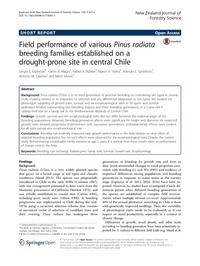Field performance of various Pinus radiata breeding families established on a drought-prone site in central Chile
Autor
Espinoza-Meza, Sergio
Magni, Carlos R.
Rubilar, Rafael A.
Yañez, Marco A.
Cabrera-Ariza, Antonio
Santelices-Moya, Rómulo
Ivković, Miloš
Fecha
2017Resumen
Background: Pinus radiata D.Don is in its third generation of selective breeding on contrasting site types in central
Chile, creating interest in its responses to selection and any differential adaptation to site types. We studied the
phenotypic variability of growth traits, survival and six ecophysiological traits in 30 open- and controlpollinated
families, representing two breeding regions and three breeding generations, in a 2-year-old P.
radiata field trial on a sandy soil in the Mediterranean drylands of Central Chile.
Findings: Growth, survival and the ecophysiological traits did not differ between the regional origin of the
breeding populations. However, breeding-generation effects were significant for height and diameter. As expected,
growth traits showed progressive improvement with successive generations. Individual-family effects were evident
for all traits except one ecophysiological trait.
Conclusions: Breeding has evidently improved early growth performance in the field, despite no clear effect of
regional breeding population, but no such effects were observed for the ecophysiological traits. Despite the current
study demonstrating considerable family variation at age 2 years, it is unclear how these results relate to performance
of mature trees in the field.
Fuente
New Zealand Journal of Forestry Science, 47Identificador DOI
doi.org/10.1186/s40490-017-0093-3Colecciones
La publicación tiene asociados los siguientes ficheros de licencia:


